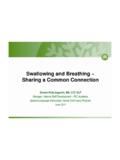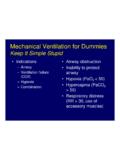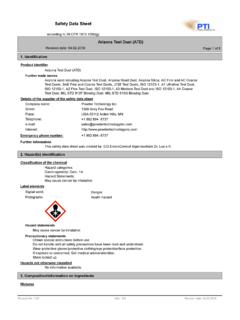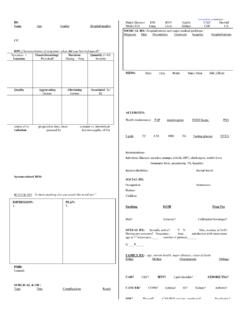Transcription of I 1 MATERIAL SAFETY DATA - microscopynotes.com
1 I 1 MATERIAL SAFETY data SHEET I I PRODUCT NAME: CORCRAFT LIQUID BLEACH EFFECTTVE DATE: 810 112002 ISSUED BY: Great MeadowNashington Industries NYS Division of Industry POBox51 Comstwk, NY 12821 THIS MATERIAL SAFETY data SHEET (MSDS) HAS BEEN PREPARLD IN COMPLIANCE WITH THE FEDERAL OSHA HAZARD COMMUNICATION STANDARD, 29 CFR 1910 1200. THIS PRODUCT MAY BE CONSIDERED TO BE AHAZARDOUS CHEMICAL UNDER THAT STANDARD. (REFER TO THE OSHA CLASSIFlCATION IN SEC 1.) THIS INFORMATION IS REQUIRED TO BE DISCLOSED FOR SAFETY lN THE WORKPLACE. THE EXPOSURE TO THE COMMUNITY, IF ANY, IS QUITE DLFFEREhT I -PRODUCT LDENmCATION Product Name: Sodium Hypochlorite Synonyms: Liquid chlorine solution, Liquid bleach, Hypochlorite, Bleach, Hypo Chemical Family: Hypochlorite Formula: NaOCL in water Use Description: textile/lamdty bleaching agent, hard surface cleaner Hazard Classification: Oxidizer, unstable (reactive), corrosive, lung toxin II - COMPONENT data Product Composition CAS or Chemical Name: Sodium HypocNonte CAS Number: 7681-52-9 Percentage Range: 7- 15% Hazar&us Per 29 CFR : Yes Exposure Standards: None Established for Sodium Hypochlonte, see Hazardous Decomposition, Sec.
2 VII CAS or Chemical Name: Water CAS Number: 7732-18-5 Percentage Range. Hazardous Per 29 CFR : No Exposure Standards: None Established. CAS or Chemcal Name: S&um hydroxide CAS Number: 1310-73-2 Percentage Range: - 2 5 Hazardous Per 29 CFR : Yes Exposure Standards: OSHA (PEL) * ACGM(TLV) PPm mg/m 3 PPm mg/m 3 ?WA : NIA 2 NIA None CEILING: NIA None NIA 2 STEL: N/A None NIA None * Federal OSHA PEL. State OSHA PEL may be different. CAS or Chemical Name. Sodmm chloride CAS Number; 7647-14-5 Percentage Range: - 12 0 Hazardous Per 29 CFR 19 : Yes Exposure Standards: None Established LII - PRECAUTIONS FOR SAFE HANDLING AND STORAGE DO NOT TAKE INTERNALLY AVOID CONTACT WITH SKIN OR EYES, UPON CONTACT WITH SKIN OR EYES, WASH OFF WITH WATER. AVOID BREATHING MIST OR VAPOR. STORAGE CONDITIONS: Store in a cool, dry, wcll-ventilated area.
3 Avoid high temperatures and exposure to and dmct sunlight. DO NOT STORE AT TEMPERATURES ABOVE: 15-21 Deg. C (60-70 Deg. F) OTHER Store in the dark at the lowest possible temperature, but keep from freezing. PRODUCT STABILITY AND COMPATIBILITY: SHELF LIFE LIMITATIONS: Up to 6 monlls a1 60 Deg. F. or lower INCOMPATIBLE MATERIALS FOR PACKAGING: Metal containers. INCOMPATIBT .E MATERIALS FOR STORAGE OR TRANSPORT: Oxidizers, acids, nitrogen contaimng materials such as quaternary ammonium salts, metals such as copper, nickel or cobalt. IV -PHYSICAL data Appearance: Greenish-yellow liquid Freezing Point: -20 deg C @ 7% NaOCl Boiling Point: Decomposes on heating Decomposihon Temperature: Decomposition rate increases as heated Bulk Density: Not Applicable pH (920 deg C 12-14 Vapor Pressure @j? 20 deg C: No data Solubility in Water. mscible Volatdes, Percent by Volume: Evaporahon Rate: No data Vapor Density- No data Molecular Weight: (active mgrehent-NaOC1) Odor: Cllonne-like Coefficient of OiYWater Distnbution: No data Spe~ific Gravity: - V - PERSONAL PROTECTIVE EQUIPMENT REQUIREMENTS Personal Protection for Routine Use of Product: Respiratory Protection: approved respirator.)
4 Concentrahons above the TLV for chlorine may occur unexpectedly. Ventilation use general exhaust ventilation. Skin and Eye Protection: Routine. Ifvapors, mists. or aerosols are not controlled with ventilation to below the TLV wear a NIOSH Line breakinghose connectiondsamples, etc.: Wear a NOSH approved workplace respirator as ir Routine. Local exhaust ventilaoon IS recommended ifvapors. mists or aerosols are generated. Othemme. Line breakinghose connectiondsamples, etc Use local exhaust ventilation Routine. Use chemical SAFETY goggles and mpermeablc gloves. Line breakinghose connectiondsamples, etc.: Wear chemical SAFETY goggles and face sheld. Other: Emergency eye wash and SAFETY showers must be prowded in the immediate work area impermeable glovcs, boots and protective suit 2 Equipment Specifications (When Applicable): chlonne gas and dust mist pre-filters.
5 Respirator Type: NOSH approved respirator equipped with chemical cartridges for protecQon against Protective Clothing Type. (lks includes: gloves, boots, apron, proteclve suit.) Neoprene V1- FIRE AND EXPLOSION HAZARD INFORMATION Flammability data Explosive: NJA Flammable: No Combustible: No Pyrophoric- No Flash Point Not Applicable Auto Ignirion Temperature: Not Applicable Flammable Limits at Normal Atmosphenc Temperature and Pressure (Percent Volume in Air). LEL - Not Applicable UEL - Not Applicable Health: Not Established Flammability: Not Established Reacbvity . Not Established Health. 3 Flammability. 0 Reactivity: 2 NFPA Rabngs HMIS Rabngs Extinguishing Media. Not applicable Fire Fighting Techniques and Comments: Use water to cool containers exposed to fire On small fire, use dry chemical. carbon &oxide or water spray On large fires, use water in flooding quantities as fog.
6 In case of fire. hazardous concentrations of cNonne may be formed. see Section XI for personal prolectiw equlpment for fire fighmg. W - REACTMTY INFORMATION Conditions Under Which This Product May Be Unstable: Temperatures Above. Decomposibon rate increases as it is heated Mechanical Shock or Impact. No Electrical (Static) Discharge: No Other. Decomposilon will result in formation of oxygen from contact with copper, mckel, cobalt and iron. Hazardous Polymerization: Will not occur. Incompatible Materials. Iron, coppcr, nickcl, cobalt, acids, ammonium or other nitrogen containing compounds. organics? other omdizers. Hazardous Dccomposilon: Chlonnc gas. Other conhtions to avoid: High heat, sunlight and ultra-violet light. Summary of Reactivity: Explosive. NIA Oxidizer Yes P\.Tophoric. No Organic Peroxide. No Water Reactive: No Corrosive: N/A Eyes: Immediately flush with large amounts of water for at least 15 minutcs, occasionally lfing the upper and lower eyelids.
7 Seek medical attention at once. Skin: Immediately flush wth water for at least 15 minutes Seek mdcal attention If clothing, slioes andor jewelry come in contact with the product, they removed immediately and laundered bcforc rc-usc Ingestion: immediately drink large quantities of water. DO NOT induce vomiting. Seek medical attention at once. DO NOT give anything by mouth if the person is unconscious or if having convulsions. Inhalation: If person expenerices nausea, headache or dizziness, person should stop work immediately and move to fresh air until these symptoms disappear. If breathing is difficult, administer oxygcn, keep the person warm and at rest. Seek mdcal attention. in the event that an individual inhales enough vapor to lose consciousness, person should be moved to fresh air at once and seek medid attention immediately.
8 Ifbreathing has stopped, artificial respiration should be given immediateIy. In all cases, ensure adequate ventilation and provide respiratory protection before he person returns to work. IX - TOXTCOLOGY AND HEALTH INFORMATION Rnutes of Absorption Inhalation: skin, eye, igeshon Warning Statements and Warning Properties: CAUSES RESPIRATORY TRACT IRRITATION. CAUSES EYE AND SKmT BURNS. CAN CAUSE LZTNG DAMAGE. Human Threshold Response data : Odor Threshold: Approximatcly 0 9 mg/M 3 ( ppm) based on odor of chlorine. Irritation Threshold. No data for Sodium hypochlorite. However, decomposition products may be Immediately Danger to Life or Health No data . However, Sodium hypochlonte has the potential to be irntatmg inundately dangerous to life or health Signs, Symptoms and Effects of Exposure: In hala tion : bums to the respiratory tract wth the production of lung edema, which can rcsult in shortness of breath, wheezing, choking, chest pain, and impairment of lung function.
9 Inhalation of hgh concentrations can result in permanent lung damagc. Chronic: Repeated inhalation exposure may cause impamnent of lung function and permanent lung damage Skin: Acute: Dermal exposure can cause severe irntation andor burns characterized by redness. swelling and scab formation. Prolongcd skin expsurc may cause destruction of tlic dcrmis with iinprllrmcnt of the skin at site of contact to regenerate effects secondary to tissue destruction. Eye: and corneal damage. Ingestion : InteStlnes, characterized by nausea, vomiting, diarrhea. abdornird pain. bleeding. and/or ussue ulceration Acute: Inhalation of this MATERIAL is irntahng to the nose, mouth, throat and lungs. It may also cause Chronic: Effccts from chroruc skin exposure would bc similar to those from single cxposure except for Severe imtation and/or burns can occur followng eyc exposure Contact may causc impairment of \mion Acute: Imtation and/or burns can occur to the entm gastrointestmal tract includmg the stomach and Chronic: There arc no known or reported effects from chronic cxposurc Me&& Condibons Aggravated by Exposure Asthma and respiratory and cardiovascular discasc Interachons wth other chemicals whch enhance toxicity none known or reported Animal Toxicology Acute Target Organ Toxicity: INHALATION LCSO No avarlable data ORAL LDSO.
10 DERMAL LD50 Approximately 3-5 g/kg (rat) > 2 gikg (rabbit) Causes bum to &yes and skin. Chronic Target Organ Toxicity: There are no know or reported effects from repeated exposure. Reproductive and Developmental Toxicity: There are no known or reported effect; on reproductive function or fetal development Carcinogenicity: Sodium hypochlonte has been shown not to be carcinogenic in laboratory animals. It IS not included as a carcinogen by IARC, OSHA, NTP, or EPA. IARC has concluded that there is inadequate evidence for the carcinogenicity of hypochlorite salls in laboratory animal; and there is no data ava&ible from studies in humans Therefore, IARC considers hypochlorite salts to be not classifiable as to their carcinogenicity to humans. Mutagenicity: Sodium hypochlonte has been shown to produce damage to genetic MATERIAL when tested in vitro.





